PAPER 1
THEORY
SECTION A
1. Which one of the following would occur if a potato strip was placed in distilled water?
A. Increase in length.
B. Strip would soften.
C. Decrease in length.
D. Remain unchanged.
2. When a seeding is fixed on a clinostat and placed in a horizontal position, the shoot continues to grow horizontally, but without the clinostat it bends upwards. Which one of the following is true about the role of the clinostat?
A. Enables the seedling to receive uniform light.
B. Causes auxin to accumulate on the lower side of the seedling.
C. Causes auxin to accumulate uniformly on all sides.
3. The following are some features of lower plants
(i) Reproduce by spores.
(ii) Lack vascular tissues.
(iii) Grow in damp places.
(iv) Have simple stem and leaves.
Which of the features belong to both mosses and ferns?
A. (i) and (iv)
B. (i) and (iii)
C. (ii) and (iii)
D. (iii) and (Iv)
4. Which part of a flowering plant is represented by figure 1 below?
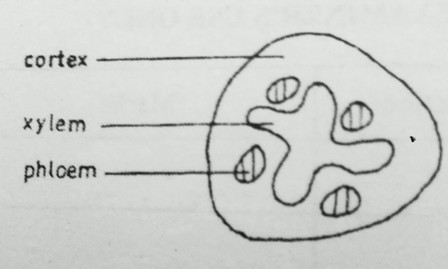
A. Monocotyledonous stem.
B. Dicotyledonous stem
C. Monocotyledonous root.
D. Dicotyledonous root.
5. The following are products of tissue respiration in living organisms.
(i) Energy.
(ii) Carbon dioxide.
(iii) Water.
(iv) Ethanol.
(v) Lactic acid.
Which of them are common to both aerobic and anaerobic respiration in plants?
A. (i) and (ii)
B. (ii) and (iii)
C. (i), (ii) and (iii)
D. (ii), (iv) and (v)
6. A student wanted to determine the percentage of air in a soil sample. The following measurements were obtained.
Volume of dry soil = 250 cm3
Volume of water added = 160 cm3
Volume of mixture of soil + water = 380 cm3
What was the percentage of air in the soil sample?
A. 7.9
B. 12
C. 25
D. 34
7. Which one of the following groups of animals uses gills, skin, buccal cavity and lungs for gaseous exchange at some stage in their life cycle?
A. Fish
B. Amphibians
C. Reptiles
D. Mammals
8. A student noted the following characteristics on a vertebra
(i) Long neural spine
(ii) Wide neural canal
(iii) Short transverse process.
The vertebra was
A. Cervical
B. Atlas
C. Thoracic
D. Lumbar
9. Which one of the following may result from lack of progesterone hormone in a woman?
A. Implantation may not occur.
B. Miscarriage may occur.
C. Menstartion may not occur.
D. Ovulation may not occur.
10. Which one of the following fruits is an example of a drupe?
A. Avocado.
B. Passion.
C. Tomato.
D. Orange.
11. To identify a substance Y, a student performed the following experiment.
| Test | Observation |
| (i) Heated Y with Benedict's Solution | Solution remained blue |
| (ii) heated Y with hydrochloric acid, cooled, added sodium hydrogen carbonate, benedict's solution, then heated again. | solution turned from blue to orange. |
From the observations, the most likely food substance in Y is
A. Starch.
B. Maltose
C. Sucrose
D. Glucose
12. Which one of the following is true of both photosynthesis and respiration?
A. Involve enzymes.
B. Need light energy.
C. Are exothermic.
D. Occur in all living organisms.
13. The reason why urine of a healthy person does not contain glucose is that
A. The glomerulus is impermeable to glucose.
B. Glucose is used for respiration before reaching the collecting duct.
C. Glucose passes back into the blood stream.
D. The kidney converts glucose to urea.
14. Which one of the following reactions is likely to occur when a donor of blood group A gives blood to a recipient of blood group B?
A. Antibodies a react with antigens B.
B. Antigens B react with antibodies b.
C. Antibodies b react with antigens A
D. Antigens A react with antigens B.
15. When round bean plants and long - selected bean plants were crossed, all the offspring were oval - seeded plants. This is an example of
A. Complete dominance.
B. Incomplete dominance.
C. Mutation.
D. Recessive genes.
16. Which one of the following may not be used for classifying insects?
A. Mouth parts.
B. Feeding habits.
C. Structure of legs.
D. Type of eyes.
17. Which one of the following is a possible sequence of plant succession on an undeveloped piece of land?
A. Fungi - ferns - shrubs - trees.
B. Fungi - mosses - shrubs - trees
C. Mosses - trees - fungi - ferns.
D. Mosses - herbs - shrubs - trees.
18. The graph below shows the effect of varying pH on the time taken for an enzyme to break down food.
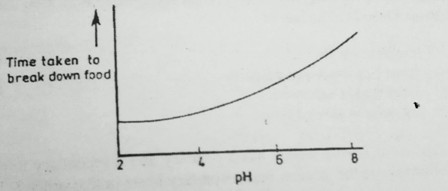
Which one of the following enzymes below could have given that response?
A. Pepsin.
B. Lipase.
C. Salivary amylase.
D. Trypsin.
19. Which one of the following fins provides a major population force in a fish?
A. Caudal.
B. Pectoral.
C. Dorsal.
D. Pelvic.
20. Which one of the following characteristics of respiratory surfaces is true of humans but not of insects?
A. Highly vascularised.
B. Have large surface area.
C. Moist.
D. Thin walled.
21. The rapid elongation of the hypocotyls during germination causes
A. Delay in emergence of photosynthetic leaves.
B. Cotyledons to grow above the ground.
C. Early emergence of photosynthetic leaves.
D. Cotyledons to remain below the ground.
22. Which one of the following blood vessels contains the lowest concentration of urea?
A. Hepatic portal vein.
B. Renal artery.
C. Hepatic vein.
D. Renal vein.
23. Which one of the following is the correct response to increased carbon dioxide in human blood? The rate of
A. Breathing is slowed.
B. Heart beat is slowed down.
C. Heart beat is increased.
D. The pulse is slowed down.
24. The tapeworm Taenia sodium has a primary and a secondary host. Which of the following are the primary and secondary hosts in that order?
A. Pig and man.
B. Cow and man.
C. Man and cow.
D. Man and pig.
25. Which one of the following statements is not correct about photosynthesis?
A. Water is required.
B. Oxygen is a by-product.
C. Sugar is a product.
D. Energy is released.
26. Figure 2 below shows the cycling of oxygen between the atmosphere and living cells.
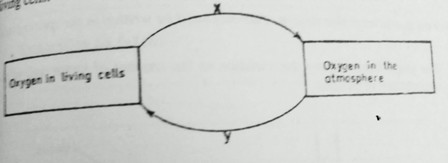
Which process is represented by letter X?
A. Excretion.
B. Respiration.
C. Decay.
D. Photosynthesis.
because they have to generate higher pressure.
A. Atria are thicker because they have to resist higher pressure.
B. Ventricles are thicker because they have to generate higher pressure.
C. Ventricles are thicker because they have to resist higher pressure.
27. Which one of the following controls the rate of heart beat in a mammal?
A. Cerebrum.
B. Pituitary.
C. Medulla oblongata.
D. Cerebellum.
28. Which one of the following events occurs during osmosis?
A. Solute molecules move from more to less concentrated solution.
B. Solvent molecules move from more to less concentrated solution.
C. Solvent molecules move from less to more concentrated solutions.
D. Solute molecules move from less to more concentrated solution.
29. Which of the following is characteristic of a soil with low capillarity?
A. Poor water retention.
B. Poor drainage.
C. Poor aeration.
D. Small particles.
SECTION B
Answer all questions in this section. Answers must be written in the spaces provided.
30. The graph below show the variation in the amount of sweat and urine with temperature in humans.
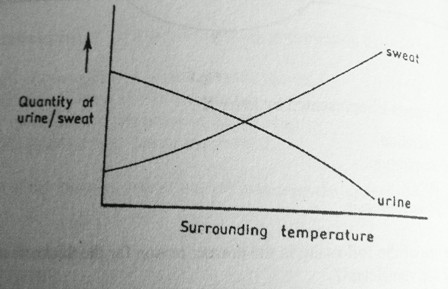
a) How does the increase in temperature affect
(i) Urine production?
(ii) Sweat production?
b) Explain your answers in (a) (i) and (ii) above.
(i) Explanation for (a) (i)...........................................................................
(ii) Explanation for (a) (ii).........................................................................
c) State three conditions under which humans pass out concentrated urine.
(i) .............................................................................................................
(ii) ............................................................................................................
(iii) ............................................................................................................
d) Apart from sweating, state three other body responses by mammals to overheating.
(i) ...........................................................................................................
(ii) ...........................................................................................................
(iii) ...........................................................................................................
31. Figure 3 below is an experimental set up to investigate the conditions for photosynthesis. The plant is in light but had previously been kept in the dark overnight.
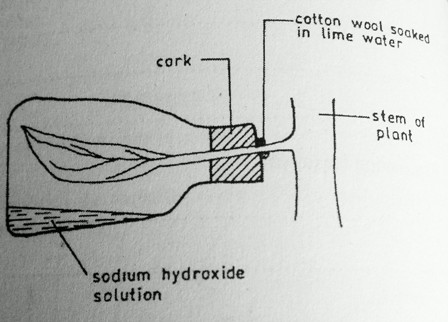
a) Which condition is being investigated?
b) Why
(i) Was it necessary to keep the plant in the dark overnight?
(ii) Is the leaf left attached to the plant?
c) What is the purpose of sodium hydroxide in the flask?
d) (i) How would you test for starch in the leaf after some time?
32. The information below is on feeding relationships in an ecosystem.
Lizards feed on praying mantis, butterflies and herbivorous bugs. Praying mantis feed on butterflies and herbivorous bugs. Butterflies and herbivorous bugs feed on grass.
a) Using a suitable method show the feeding relationship between
(i) All the organisms.
(ii) The praying mantis, herbivorous bug, lizards and grass.
b) How would the population of the organisms in (a) (i) above is affected if the praying mantis were removed from the ecosystem?
c) (i) State one group of important organisms that have not been included in the ecosystem.
(ii) Why are the organisms named in (c) (i) above important in an ecosystem?
33. Figure 4 below shows a section through the human eye.
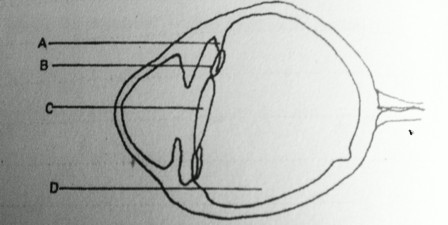
a) Name the parts labelled A, B, C and D.
A ...............................................................................................
B .............................................................................................
C ..............................................................................................
D..............................................................................................
b) What function is performed jointly by the parts A, B, C and D?
c) Other than the joint function, state two other functions of the part labelled D.
d) Give the state of parts A, B and C when the eye is viewing.
(i) Near objects.
A ...............................................................................................
B ................................................................................................
C ................................................................................................
(ii) Distant objects.
A .............................................................................................
B ............................................................................................
C ............................................................................................
e) State two eye defects and how they are corrected.
(i) Defect.....................................................................................
Corrective measure .............................................................
(ii) Defect ...................................................................................
Corrective measure ............................................................
SECTION C
Answer any two questions.
34. a) State the dangers of a parasitic mode of life.
b) Describe how a tapeworm is adapted to its mode of life.
35. a) Describe the digestion of proteins in a mammal.
b) Explain how the ileum is suited for its mammal.
36. a) With the aid of well labelled diagrams explain the difference between hypogeal and epigeal germination.
b) Describe an experiment you would carry out to show that heat is liberated by germinating seeds.
37. a) Explain why a skeleton is necessary in a mammalian body.
b) With the aid of diagrams describe how a human arm can bend and straighten.
